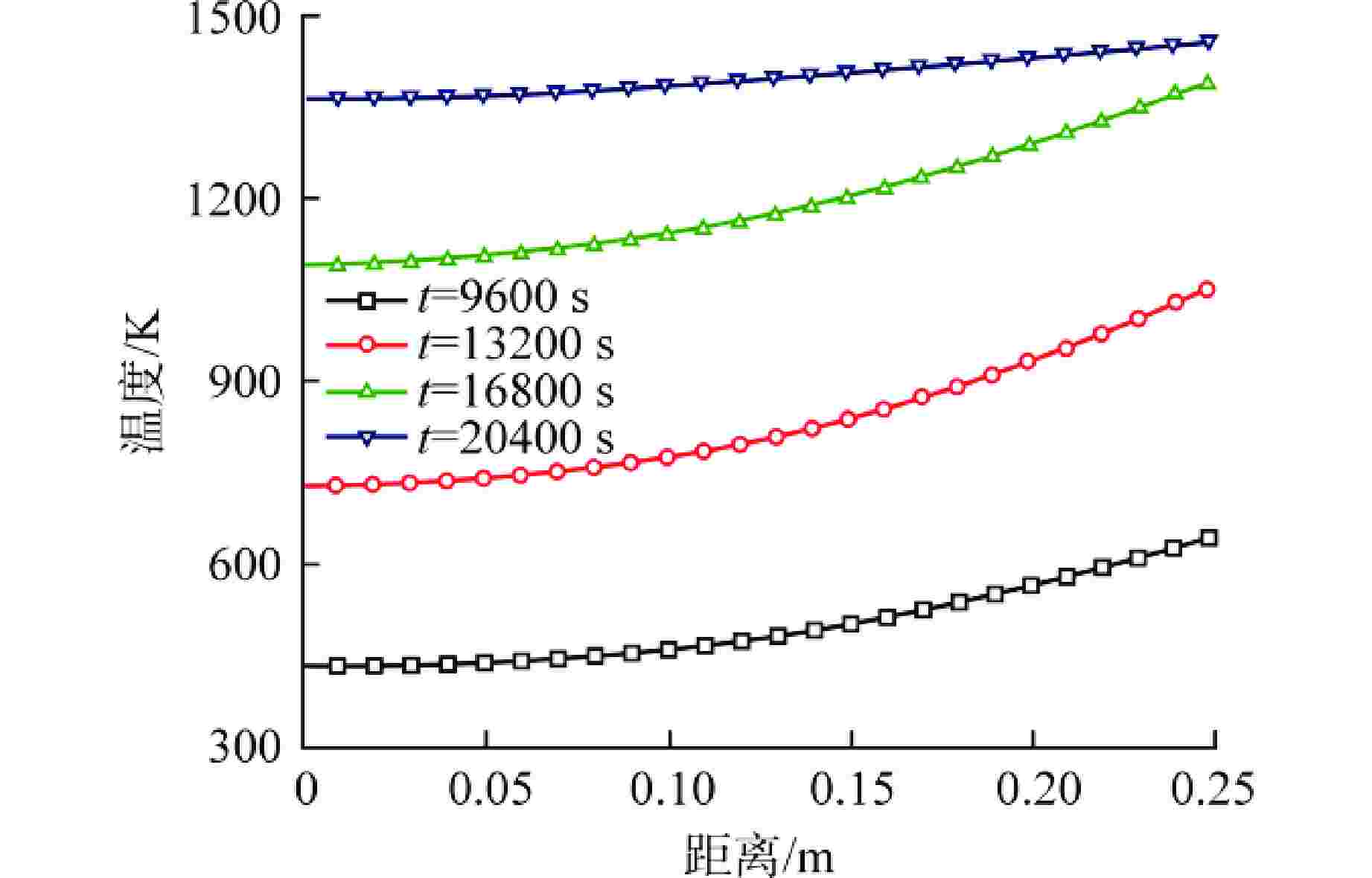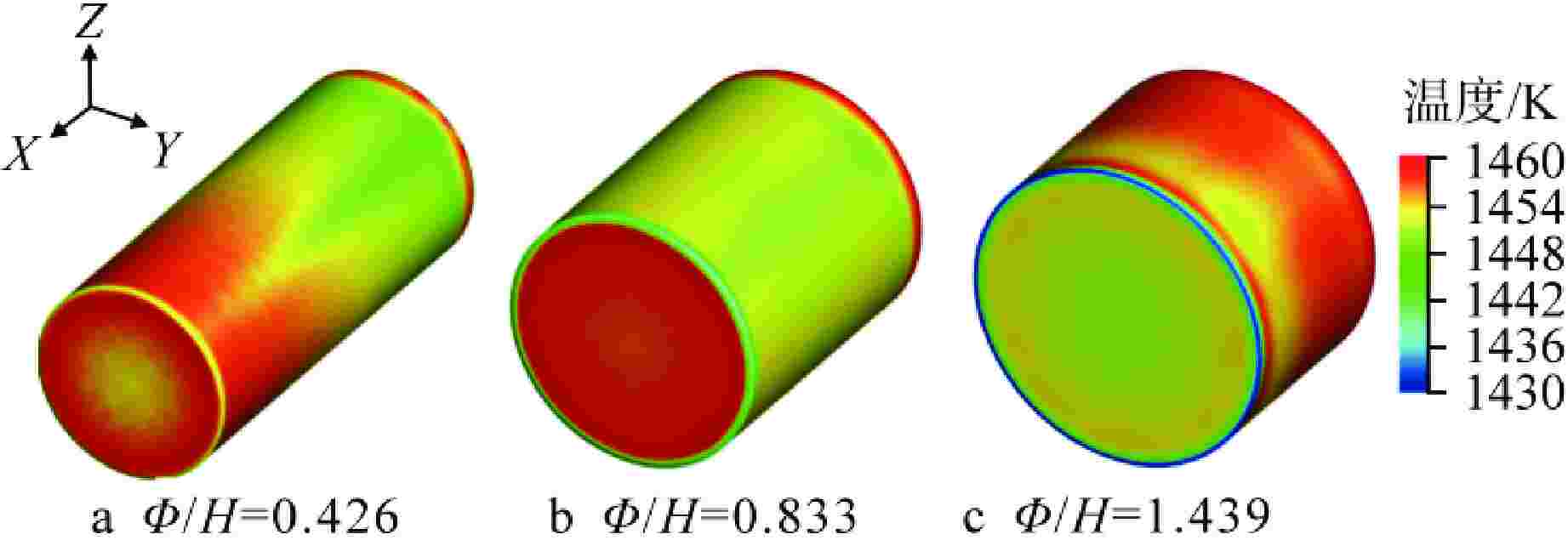Research on Thermal Response Characteristics of Space Nuclear Power in High-Temperature and High-Velocity Impact Experiment under Accidental Reentry
-
摘要: 高温高速撞击模拟试验是考核空间核反应堆异常再入大气层撞击地面事故安全性的重要项目。本文针对试验热加载和高速飞行阶段,建立了耦合传导、对流和辐射的有限体积模型,数值研究了试验中空间核反应堆堆芯模拟件的热响应特性,分析了加载温度变化速率和径高比的影响。结果表明,热加载阶段,堆芯模拟件最高温度和最低温度分别位于侧面及底面的交界处和模拟件中心;达到热平衡的时间除受加载温度变化速率的影响外还取决于模拟件径高比。高速飞行阶段,堆芯模拟件最高温度和最低温度所在位置与热加载阶段相反,且最低温度随着径高比和飞行时间的增加而减少。研究成果能够支撑高温高速撞击模拟试验系统研制及试验设计。
-
关键词:
- 空间核反应堆 /
- 异常再入事故 /
- 高温高速撞击模拟试验 /
- 数值仿真 /
- 热响应特性
Abstract: High-temperature and high-velocity impact simulation test is a significant experiment to evaluate the safety of space nuclear power reactor in the accident impact on ground after accidental reentry. In this paper, a finite volume model coupling conduction, convection and radiation is established for the heat loading and high-velocity flight phase of the test, and the thermal response characteristics of the core simulator of the space nuclear reactor in the test are numerically studied, and the effects of loading temperature change rate and diameter-height ratio are analyzed. The results show that during the heat loading phase, the highest temperature and the lowest temperature of the core simulator are located at the junction of the side surface and the bottom surface and at the center of the simulator respectively. The time to reach thermal equilibrium is not only affected by the change rate of loading temperature, but also depends on the diameter-height ratio of the simulator. In the high-velocity flight phase, the highest and lowest temperatures of the core simulator are opposite to those in the heat loading phase, and the lowest temperature decreases with the increase of the diameter-height ratio and flight time. The research results can support the development and experimental design of high-temperature and high-velocity impact simulation test system. -
表 1 计算参数设置
Table 1. Parameter Setting in the Simulation
参数 热加载阶段 高速飞行阶段 升温速率k/(K·h−1) 150/200/250 — 初始温度$ {T}_{0} $/K 300 1473 目标温度$ {T}_{\mathrm{f}\mathrm{i}\mathrm{n}} $/K 1473 >1373 径高比$ \varPhi /H $ 0.426/0.833/1.439 0.426/0.833/1.439 飞行速度
(或空气速度)$ {U}_{0} $/(m·s−1)— 90 空气温度$ {T}_{\mathrm{a}\mathrm{i}\mathrm{r}} $/K — 300 表 2 堆芯模拟件高速飞行阶段计算结果
Table 2. Numerical Results for the High-velocity Flight Phase of Reactor Core Simulator
算例 回流区长度/m $ {C}_{\mathrm{d}} $ f/Hz St $ \varPhi /H $=0.426 0.810 0.837 11.0 0.049 $ \varPhi /H $=0.833 0.840 0.855 9.8 0.054 $ \varPhi /H $=1.439 1.425 1.030 8.8 0.059 -
[1] 张泽,薛翔,王园丁,等. 空间核动力推进技术研究展望[J]. 火箭推进,2021, 47(5): 1-13. doi: 10.3969/j.issn.1672-9374.2021.05.001 [2] 龚游,王新燕,夏芸. 美国空间核动力发展态势解析[J]. 科技导报,2022, 40(12): 102-106. [3] 李永,周成,吕征,等. 大功率空间核电推进技术研究进展[J]. 推进技术,2020, 41(1): 12-27. [4] 任勇. 理想的空间电源——空间核反应堆[J]. 核动力工程,1993, 14(3): 269-273. [5] 刘佳,康小录,张岩,等. 基于核电的大功率霍尔电推进系统设计及分析[J]. 原子能科学技术,2019, 53(1): 9-15. doi: 10.7538/yzk.2018.youxian.0349 [6] 游尔胜,石磊,郑艳华,等. 球床堆在空间核动力系统中的应用[J]. 原子能科学技术,2015, 49(S1): 75-80. [7] AFTERGOOD S. Background on space nuclear power[J]. Science & Global Security, 2007, 1(1-2): 93-107. [8] LENARD R X. Nuclear safety, legal aspects and policy recommendations for space nuclear power and propulsion systems[J]. Acta Astronautica, 2006, 59(1-5): 398-412. doi: 10.1016/j.actaastro.2006.02.049 [9] COHEN A F. Cosmos 954 and the international law of satellite accidents[J]. Yale Journal of International Law, 1984, 10: 78. [10] United Nations Committee on the Peaceful Use of Space, Scientific and Technical Subcommittee. Safety framework for nuclear power source applications in outer space[Z]. Vienna, Austria: International Atomic Energy Agency, 2009. [11] SUMMERER L, WILCOX R E, BECHTEL R, et al. The International Safety Framework for nuclear power source applications in outer space-useful and substantial guidance[J]. Acta Astronautica, 2015, 111: 89-101. doi: 10.1016/j.actaastro.2015.02.007 [12] GRINBERG E I, DOSCHATOV V V, NIKOLAEV V S, et al. Thermal state of the safety system, reactor, side reflector and shielding of the “TOPAZ-2” system under conditions of fire caused by a launcher accident at the launch pad[J]. AIP Conference Proceedings, 1996, 361(1): 981-986. [13] FAIRCHILD J F, KOONMEN J P, THOME F V, et al. Thermionic system evaluated test (TSET) facility description[J]. AIP Conference Proceedings, 1992, 246(1): 836-842. [14] BENNETT G L. The safety review and approval process for space nuclear power sources[J]. Nuclear Safety, 1991, 32(1): 1-18. [15] 胡宇鹏,鲁亮,向延华,等. 深空探测器同位素热源环境试验技术[J]. 深空探测学报,2017, 4(2): 138-142. [16] OFFICE U A O. Environmental assessment of general-purpose heat source safety verification testing: DOE/EA-1025[R]. Washington: USDOE Albuquerque Operations Office, 1995. [17] 胡宇鹏,王易君,王泽,等. 同位素热源火灾事故环境模拟试验及仿真分析[J]. 原子能科学技术,2021, 55(8): 1529-1536. doi: 10.7538/yzk.2020.youxian.0562 [18] 武伟名,罗洪义,李鑫,等. 同位素热源高速撞击数值模拟研究[J]. 原子能科学技术,2020, 54(1): 140-148. doi: 10.7538/yzk.2019.youxian.0106 [19] 吴胜娜,罗洪义,武伟名,等. 再入过程中的同位素热源可靠性评估[J]. 原子能科学技术,2020, 54(2): 215-221. doi: 10.7538/yzk.2020.54.02.0215 [20] 徐伟芳,张方举,胡文军,等. 高温条件下薄壁圆柱筒高速碰撞试验[J]. 中国测试,2018, 44(10): 50-54. doi: 10.11857/j.issn.1674-5124.2018.10.008 [21] 胡文军,陈红永,陈军红,等. 空间核动力源的安全性研究进展[J]. 深空探测学报,2017, 4(5): 453-465. [22] 胡宇鹏,廖洋,彭湃,等. 大质量件高温高速撞击试验用分离式热加载装置: 中国,CN115389347A[P]. 2022-11-25. [23] 王安龄,桂业伟,耿湘人,等. 飞船返回舱气动热及烧蚀防热的不确定性初步研究[J]. 工程热物理学报,2005, 26(5): 862-864. doi: 10.3321/j.issn:0253-231X.2005.05.046 [24] 孟松鹤,丁小恒,易法军,等. 高超声速飞行器表面测热技术综述[J]. 航空学报,2014, 35(7): 1759-1775. [25] 李齐,魏昊功,李志辉,等. 月地高速再入返回器化学非平衡气动影响预测与飞行验证[J]. 中国科学: 技术科学,2021, 51(7): 813-827. -






 下载:
下载:











